Clinical Care Plan: Comprehensive Care for a Pediatric Patient
VerifiedAdded on 2021/02/19
|12
|1769
|26
Practical Assignment
AI Summary
This clinical care plan details the comprehensive care provided to a 5-year-old boy who sustained lacerations after a fall from a tricycle. The plan addresses various aspects of patient care, including wound management, psychological well-being, and nutritional support. It emphasizes the importance of regular wound checks, aseptic procedures, and parental involvement. Psychological care focuses on addressing the patient's anxiety about being teased, promoting sleep, and collaborating with psychological experts. Nutritional interventions involve monitoring medication and food intake, and providing a suitable diet plan to aid in wound healing. The conclusion stresses the significance of multidisciplinary teamwork in delivering effective, patient-centered care, ensuring a safe and secure environment for the patient. The document also includes references to support the interventions and care provided.
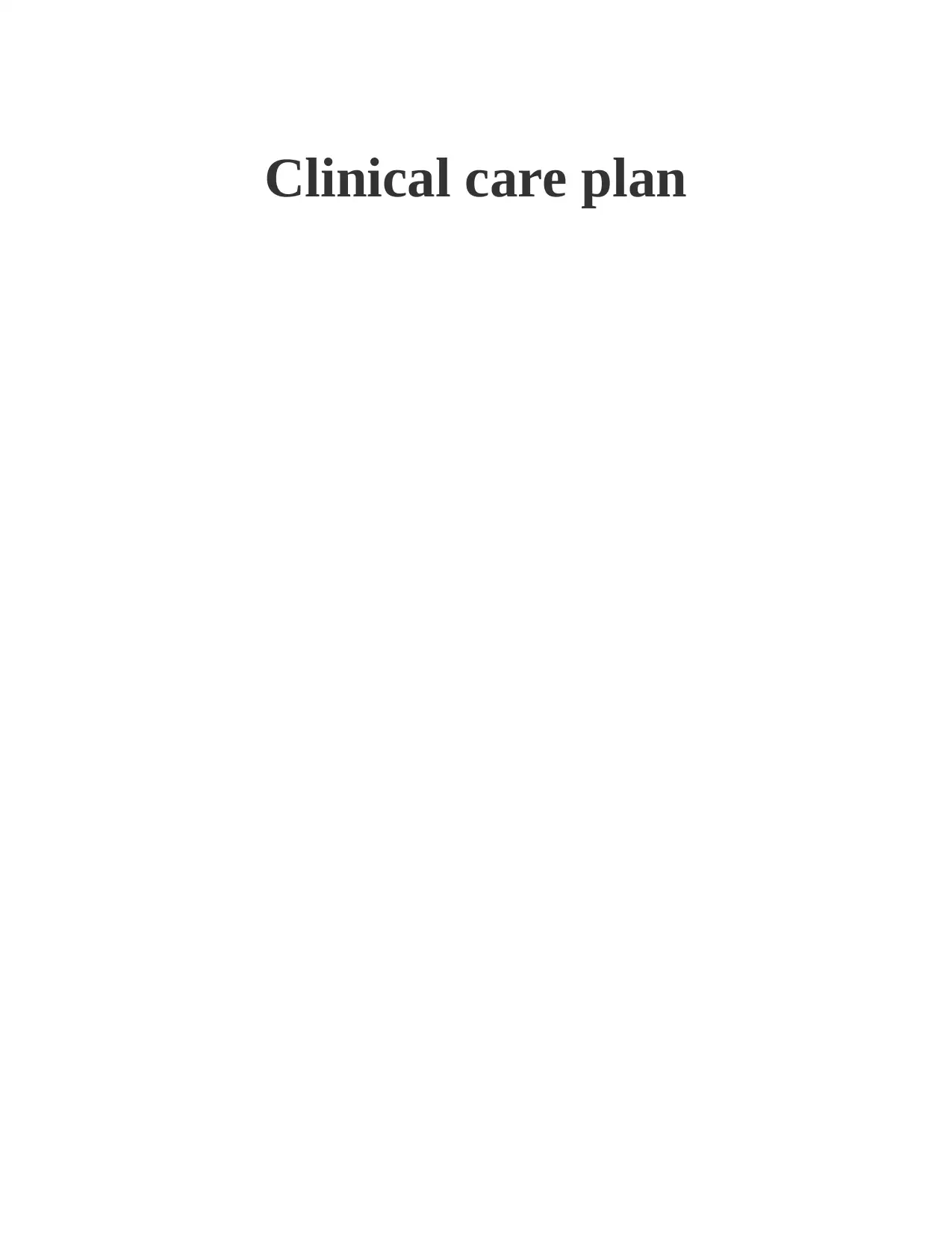
Clinical care plan
Paraphrase This Document
Need a fresh take? Get an instant paraphrase of this document with our AI Paraphraser
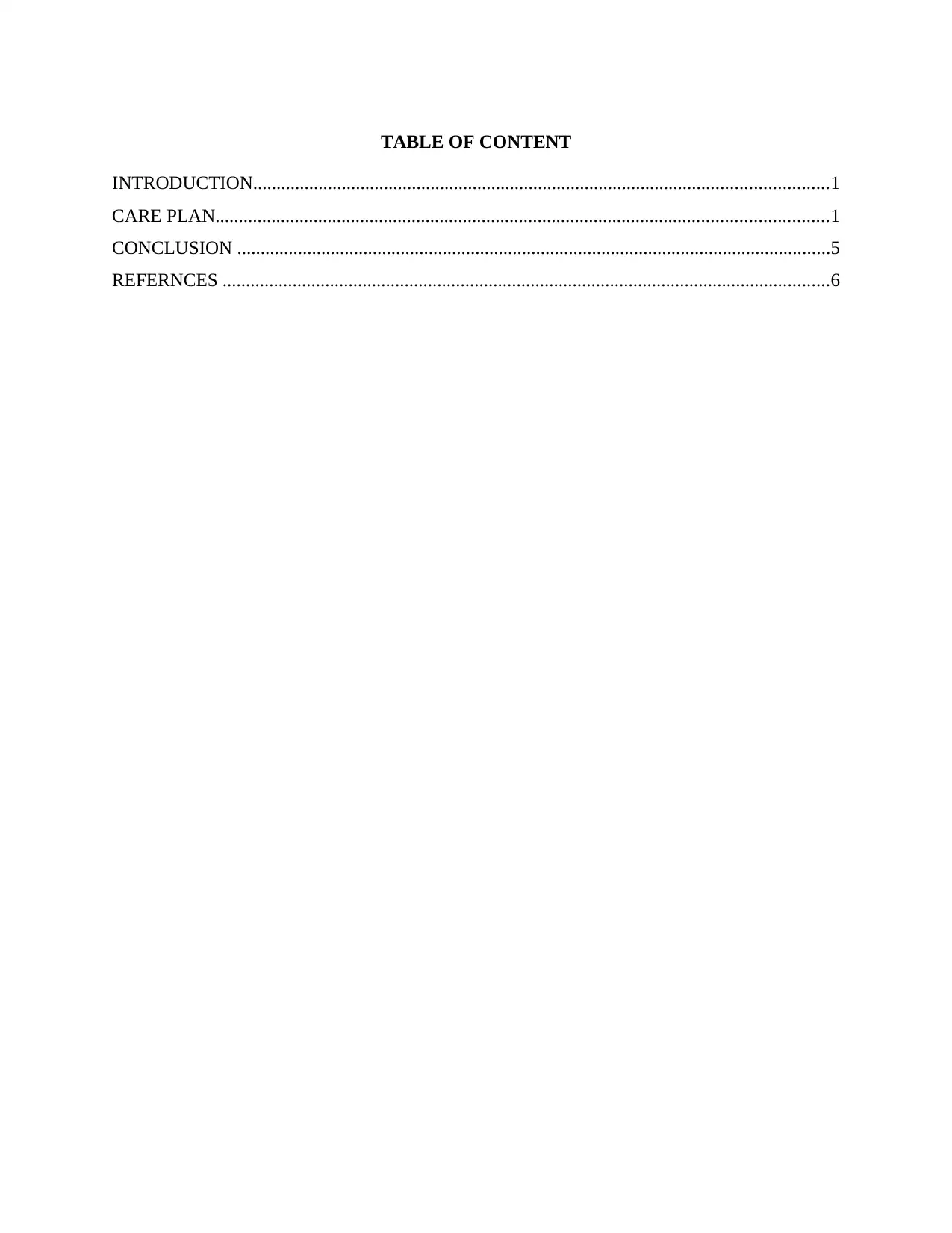
TABLE OF CONTENT
INTRODUCTION...........................................................................................................................1
CARE PLAN...................................................................................................................................1
CONCLUSION ...............................................................................................................................5
REFERNCES ..................................................................................................................................6
INTRODUCTION...........................................................................................................................1
CARE PLAN...................................................................................................................................1
CONCLUSION ...............................................................................................................................5
REFERNCES ..................................................................................................................................6
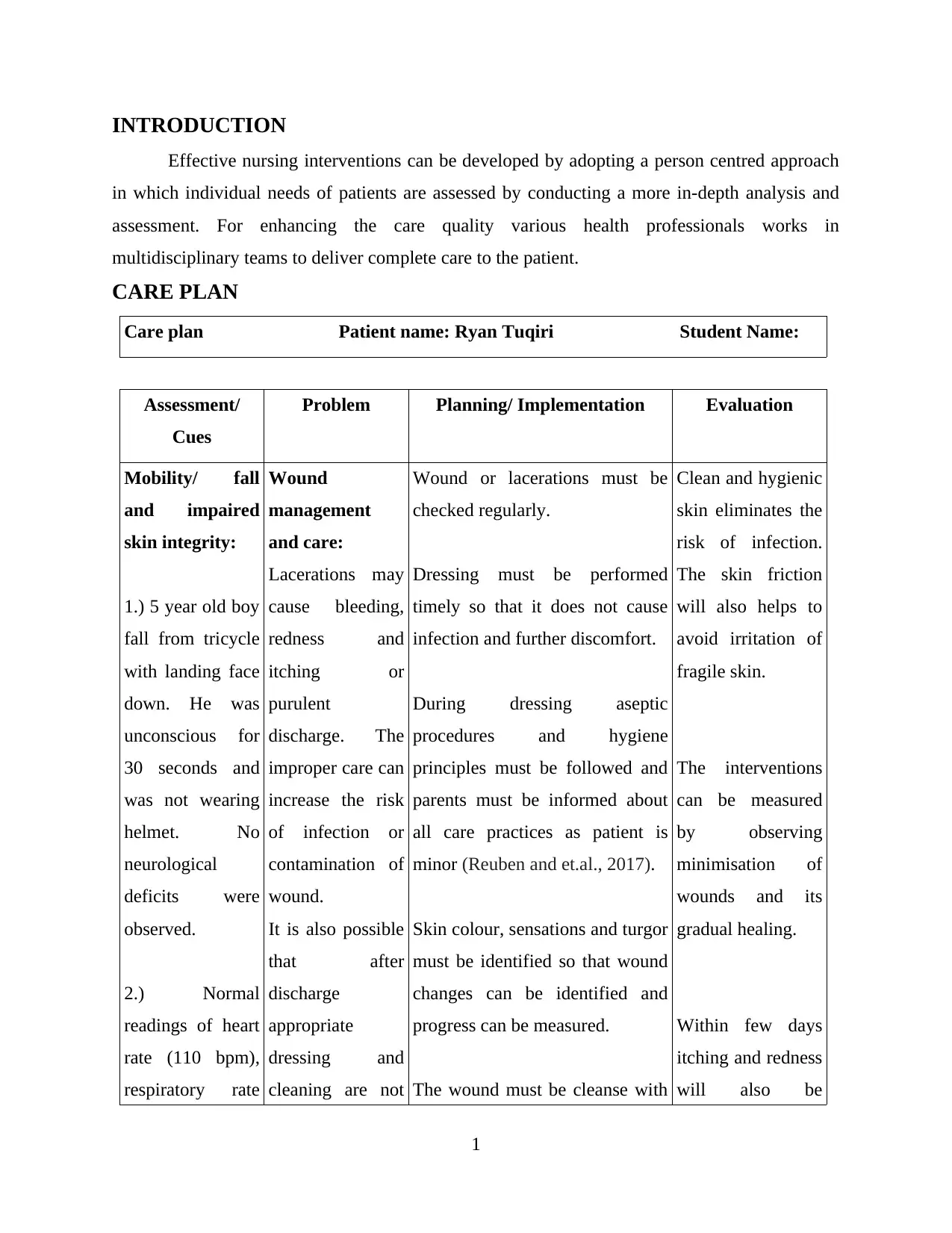
INTRODUCTION
Effective nursing interventions can be developed by adopting a person centred approach
in which individual needs of patients are assessed by conducting a more in-depth analysis and
assessment. For enhancing the care quality various health professionals works in
multidisciplinary teams to deliver complete care to the patient.
CARE PLAN
Care plan Patient name: Ryan Tuqiri Student Name:
Assessment/
Cues
Problem Planning/ Implementation Evaluation
Mobility/ fall
and impaired
skin integrity:
1.) 5 year old boy
fall from tricycle
with landing face
down. He was
unconscious for
30 seconds and
was not wearing
helmet. No
neurological
deficits were
observed.
2.) Normal
readings of heart
rate (110 bpm),
respiratory rate
Wound
management
and care:
Lacerations may
cause bleeding,
redness and
itching or
purulent
discharge. The
improper care can
increase the risk
of infection or
contamination of
wound.
It is also possible
that after
discharge
appropriate
dressing and
cleaning are not
Wound or lacerations must be
checked regularly.
Dressing must be performed
timely so that it does not cause
infection and further discomfort.
During dressing aseptic
procedures and hygiene
principles must be followed and
parents must be informed about
all care practices as patient is
minor (Reuben and et.al., 2017).
Skin colour, sensations and turgor
must be identified so that wound
changes can be identified and
progress can be measured.
The wound must be cleanse with
Clean and hygienic
skin eliminates the
risk of infection.
The skin friction
will also helps to
avoid irritation of
fragile skin.
The interventions
can be measured
by observing
minimisation of
wounds and its
gradual healing.
Within few days
itching and redness
will also be
1
Effective nursing interventions can be developed by adopting a person centred approach
in which individual needs of patients are assessed by conducting a more in-depth analysis and
assessment. For enhancing the care quality various health professionals works in
multidisciplinary teams to deliver complete care to the patient.
CARE PLAN
Care plan Patient name: Ryan Tuqiri Student Name:
Assessment/
Cues
Problem Planning/ Implementation Evaluation
Mobility/ fall
and impaired
skin integrity:
1.) 5 year old boy
fall from tricycle
with landing face
down. He was
unconscious for
30 seconds and
was not wearing
helmet. No
neurological
deficits were
observed.
2.) Normal
readings of heart
rate (110 bpm),
respiratory rate
Wound
management
and care:
Lacerations may
cause bleeding,
redness and
itching or
purulent
discharge. The
improper care can
increase the risk
of infection or
contamination of
wound.
It is also possible
that after
discharge
appropriate
dressing and
cleaning are not
Wound or lacerations must be
checked regularly.
Dressing must be performed
timely so that it does not cause
infection and further discomfort.
During dressing aseptic
procedures and hygiene
principles must be followed and
parents must be informed about
all care practices as patient is
minor (Reuben and et.al., 2017).
Skin colour, sensations and turgor
must be identified so that wound
changes can be identified and
progress can be measured.
The wound must be cleanse with
Clean and hygienic
skin eliminates the
risk of infection.
The skin friction
will also helps to
avoid irritation of
fragile skin.
The interventions
can be measured
by observing
minimisation of
wounds and its
gradual healing.
Within few days
itching and redness
will also be
1
⊘ This is a preview!⊘
Do you want full access?
Subscribe today to unlock all pages.

Trusted by 1+ million students worldwide
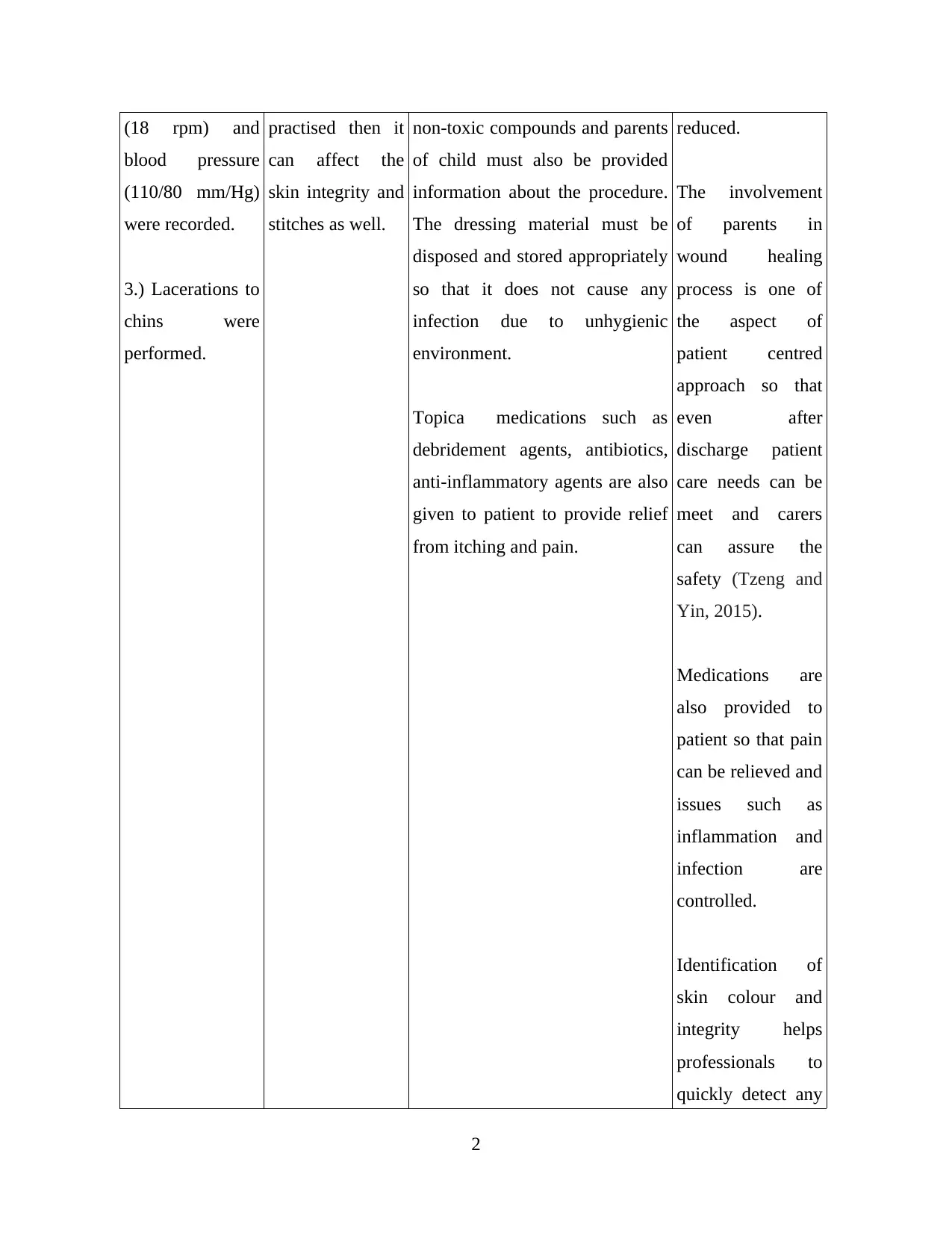
(18 rpm) and
blood pressure
(110/80 mm/Hg)
were recorded.
3.) Lacerations to
chins were
performed.
practised then it
can affect the
skin integrity and
stitches as well.
non-toxic compounds and parents
of child must also be provided
information about the procedure.
The dressing material must be
disposed and stored appropriately
so that it does not cause any
infection due to unhygienic
environment.
Topica medications such as
debridement agents, antibiotics,
anti-inflammatory agents are also
given to patient to provide relief
from itching and pain.
reduced.
The involvement
of parents in
wound healing
process is one of
the aspect of
patient centred
approach so that
even after
discharge patient
care needs can be
meet and carers
can assure the
safety (Tzeng and
Yin, 2015).
Medications are
also provided to
patient so that pain
can be relieved and
issues such as
inflammation and
infection are
controlled.
Identification of
skin colour and
integrity helps
professionals to
quickly detect any
2
blood pressure
(110/80 mm/Hg)
were recorded.
3.) Lacerations to
chins were
performed.
practised then it
can affect the
skin integrity and
stitches as well.
non-toxic compounds and parents
of child must also be provided
information about the procedure.
The dressing material must be
disposed and stored appropriately
so that it does not cause any
infection due to unhygienic
environment.
Topica medications such as
debridement agents, antibiotics,
anti-inflammatory agents are also
given to patient to provide relief
from itching and pain.
reduced.
The involvement
of parents in
wound healing
process is one of
the aspect of
patient centred
approach so that
even after
discharge patient
care needs can be
meet and carers
can assure the
safety (Tzeng and
Yin, 2015).
Medications are
also provided to
patient so that pain
can be relieved and
issues such as
inflammation and
infection are
controlled.
Identification of
skin colour and
integrity helps
professionals to
quickly detect any
2
Paraphrase This Document
Need a fresh take? Get an instant paraphrase of this document with our AI Paraphraser
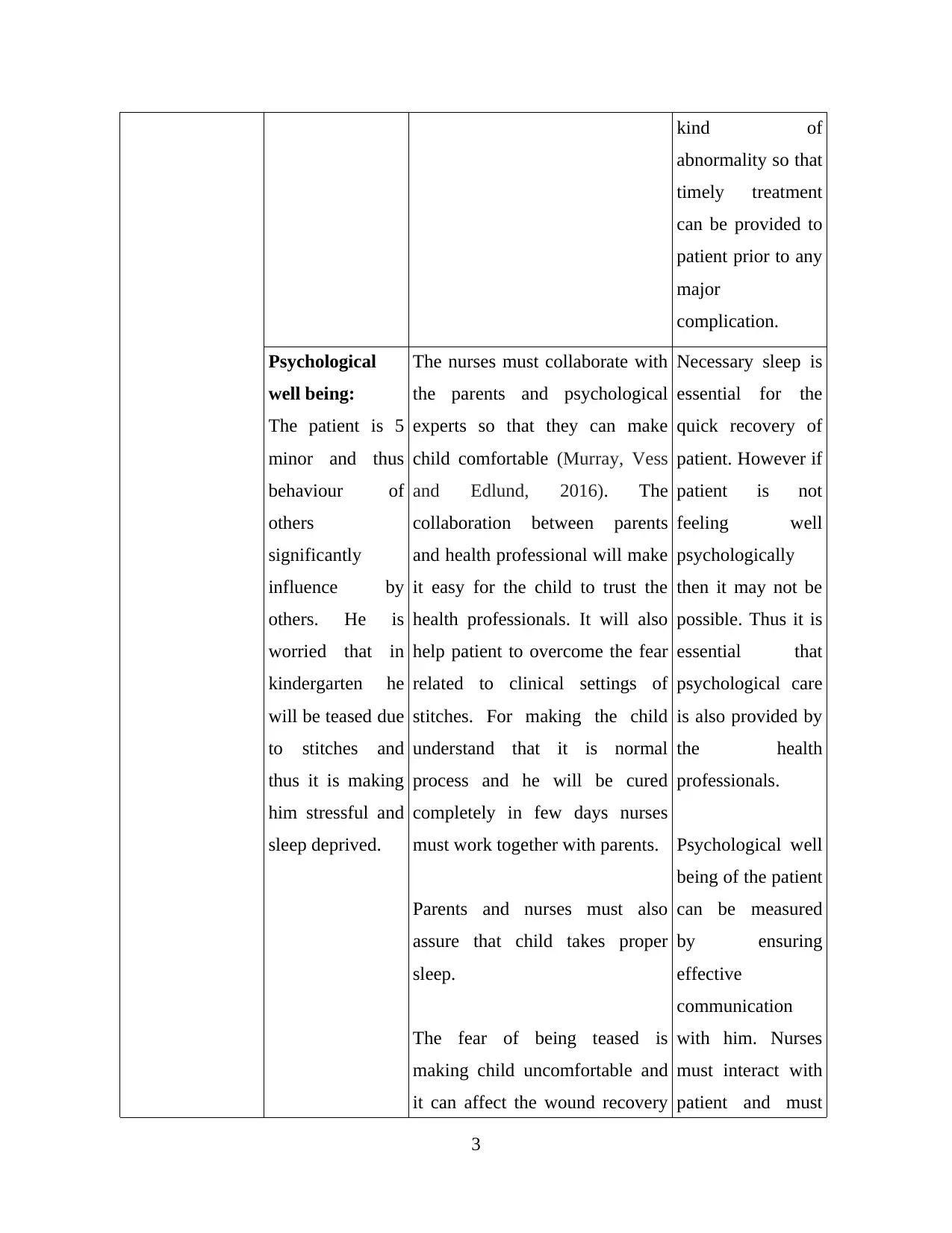
kind of
abnormality so that
timely treatment
can be provided to
patient prior to any
major
complication.
Psychological
well being:
The patient is 5
minor and thus
behaviour of
others
significantly
influence by
others. He is
worried that in
kindergarten he
will be teased due
to stitches and
thus it is making
him stressful and
sleep deprived.
The nurses must collaborate with
the parents and psychological
experts so that they can make
child comfortable (Murray, Vess
and Edlund, 2016). The
collaboration between parents
and health professional will make
it easy for the child to trust the
health professionals. It will also
help patient to overcome the fear
related to clinical settings of
stitches. For making the child
understand that it is normal
process and he will be cured
completely in few days nurses
must work together with parents.
Parents and nurses must also
assure that child takes proper
sleep.
The fear of being teased is
making child uncomfortable and
it can affect the wound recovery
Necessary sleep is
essential for the
quick recovery of
patient. However if
patient is not
feeling well
psychologically
then it may not be
possible. Thus it is
essential that
psychological care
is also provided by
the health
professionals.
Psychological well
being of the patient
can be measured
by ensuring
effective
communication
with him. Nurses
must interact with
patient and must
3
abnormality so that
timely treatment
can be provided to
patient prior to any
major
complication.
Psychological
well being:
The patient is 5
minor and thus
behaviour of
others
significantly
influence by
others. He is
worried that in
kindergarten he
will be teased due
to stitches and
thus it is making
him stressful and
sleep deprived.
The nurses must collaborate with
the parents and psychological
experts so that they can make
child comfortable (Murray, Vess
and Edlund, 2016). The
collaboration between parents
and health professional will make
it easy for the child to trust the
health professionals. It will also
help patient to overcome the fear
related to clinical settings of
stitches. For making the child
understand that it is normal
process and he will be cured
completely in few days nurses
must work together with parents.
Parents and nurses must also
assure that child takes proper
sleep.
The fear of being teased is
making child uncomfortable and
it can affect the wound recovery
Necessary sleep is
essential for the
quick recovery of
patient. However if
patient is not
feeling well
psychologically
then it may not be
possible. Thus it is
essential that
psychological care
is also provided by
the health
professionals.
Psychological well
being of the patient
can be measured
by ensuring
effective
communication
with him. Nurses
must interact with
patient and must
3
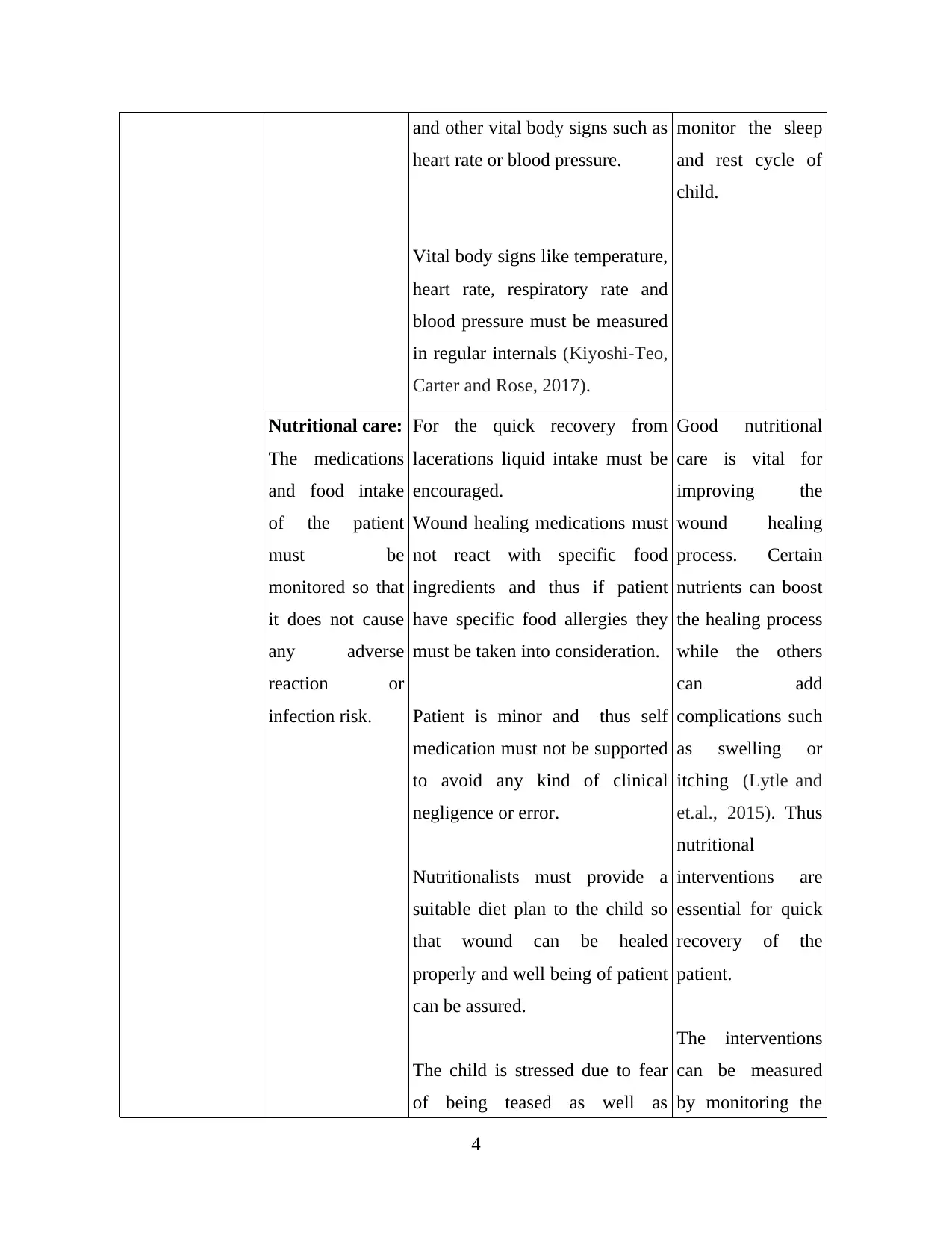
and other vital body signs such as
heart rate or blood pressure.
Vital body signs like temperature,
heart rate, respiratory rate and
blood pressure must be measured
in regular internals (Kiyoshi-Teo,
Carter and Rose, 2017).
monitor the sleep
and rest cycle of
child.
Nutritional care:
The medications
and food intake
of the patient
must be
monitored so that
it does not cause
any adverse
reaction or
infection risk.
For the quick recovery from
lacerations liquid intake must be
encouraged.
Wound healing medications must
not react with specific food
ingredients and thus if patient
have specific food allergies they
must be taken into consideration.
Patient is minor and thus self
medication must not be supported
to avoid any kind of clinical
negligence or error.
Nutritionalists must provide a
suitable diet plan to the child so
that wound can be healed
properly and well being of patient
can be assured.
The child is stressed due to fear
of being teased as well as
Good nutritional
care is vital for
improving the
wound healing
process. Certain
nutrients can boost
the healing process
while the others
can add
complications such
as swelling or
itching (Lytle and
et.al., 2015). Thus
nutritional
interventions are
essential for quick
recovery of the
patient.
The interventions
can be measured
by monitoring the
4
heart rate or blood pressure.
Vital body signs like temperature,
heart rate, respiratory rate and
blood pressure must be measured
in regular internals (Kiyoshi-Teo,
Carter and Rose, 2017).
monitor the sleep
and rest cycle of
child.
Nutritional care:
The medications
and food intake
of the patient
must be
monitored so that
it does not cause
any adverse
reaction or
infection risk.
For the quick recovery from
lacerations liquid intake must be
encouraged.
Wound healing medications must
not react with specific food
ingredients and thus if patient
have specific food allergies they
must be taken into consideration.
Patient is minor and thus self
medication must not be supported
to avoid any kind of clinical
negligence or error.
Nutritionalists must provide a
suitable diet plan to the child so
that wound can be healed
properly and well being of patient
can be assured.
The child is stressed due to fear
of being teased as well as
Good nutritional
care is vital for
improving the
wound healing
process. Certain
nutrients can boost
the healing process
while the others
can add
complications such
as swelling or
itching (Lytle and
et.al., 2015). Thus
nutritional
interventions are
essential for quick
recovery of the
patient.
The interventions
can be measured
by monitoring the
4
⊘ This is a preview!⊘
Do you want full access?
Subscribe today to unlock all pages.

Trusted by 1+ million students worldwide
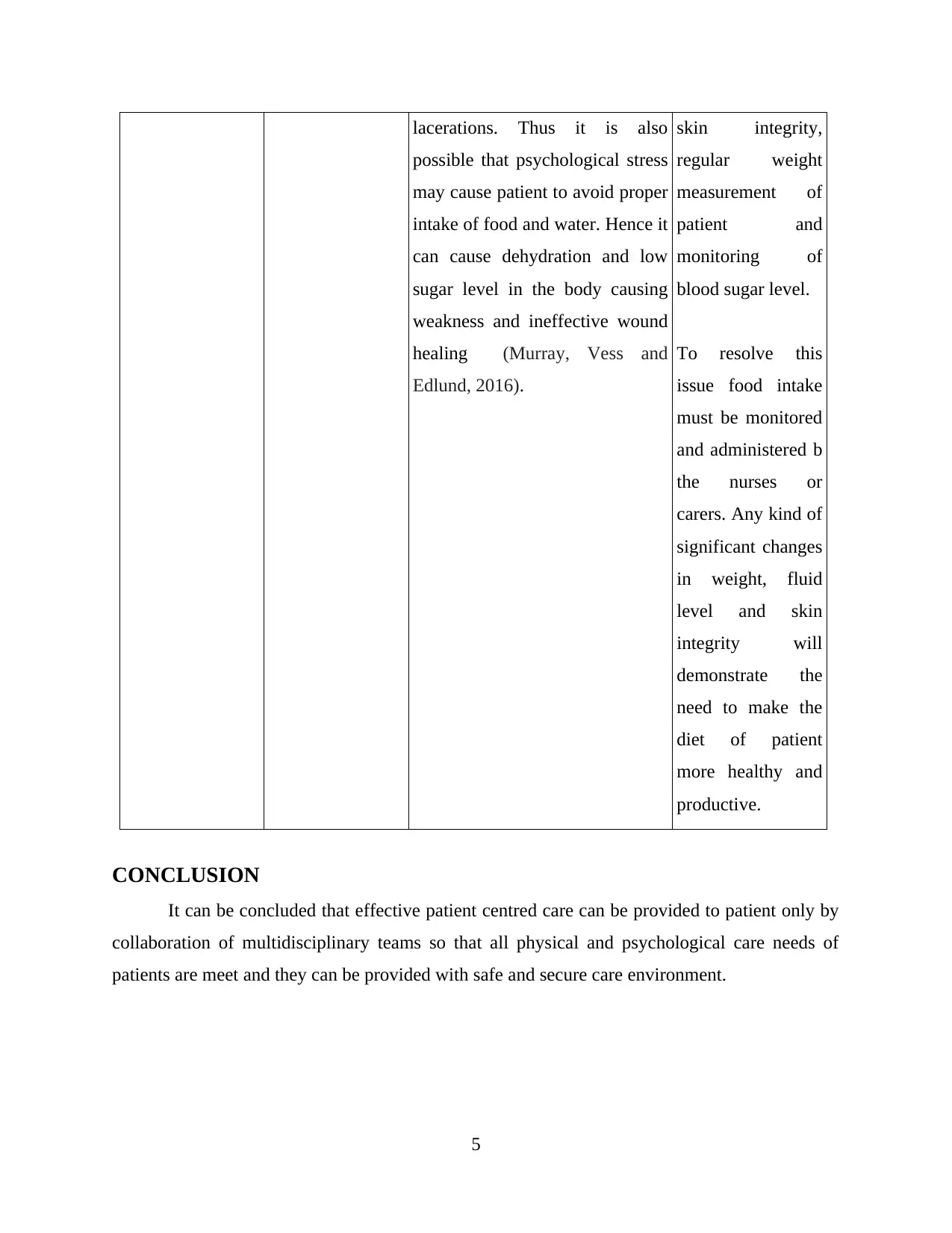
lacerations. Thus it is also
possible that psychological stress
may cause patient to avoid proper
intake of food and water. Hence it
can cause dehydration and low
sugar level in the body causing
weakness and ineffective wound
healing (Murray, Vess and
Edlund, 2016).
skin integrity,
regular weight
measurement of
patient and
monitoring of
blood sugar level.
To resolve this
issue food intake
must be monitored
and administered b
the nurses or
carers. Any kind of
significant changes
in weight, fluid
level and skin
integrity will
demonstrate the
need to make the
diet of patient
more healthy and
productive.
CONCLUSION
It can be concluded that effective patient centred care can be provided to patient only by
collaboration of multidisciplinary teams so that all physical and psychological care needs of
patients are meet and they can be provided with safe and secure care environment.
5
possible that psychological stress
may cause patient to avoid proper
intake of food and water. Hence it
can cause dehydration and low
sugar level in the body causing
weakness and ineffective wound
healing (Murray, Vess and
Edlund, 2016).
skin integrity,
regular weight
measurement of
patient and
monitoring of
blood sugar level.
To resolve this
issue food intake
must be monitored
and administered b
the nurses or
carers. Any kind of
significant changes
in weight, fluid
level and skin
integrity will
demonstrate the
need to make the
diet of patient
more healthy and
productive.
CONCLUSION
It can be concluded that effective patient centred care can be provided to patient only by
collaboration of multidisciplinary teams so that all physical and psychological care needs of
patients are meet and they can be provided with safe and secure care environment.
5
Paraphrase This Document
Need a fresh take? Get an instant paraphrase of this document with our AI Paraphraser
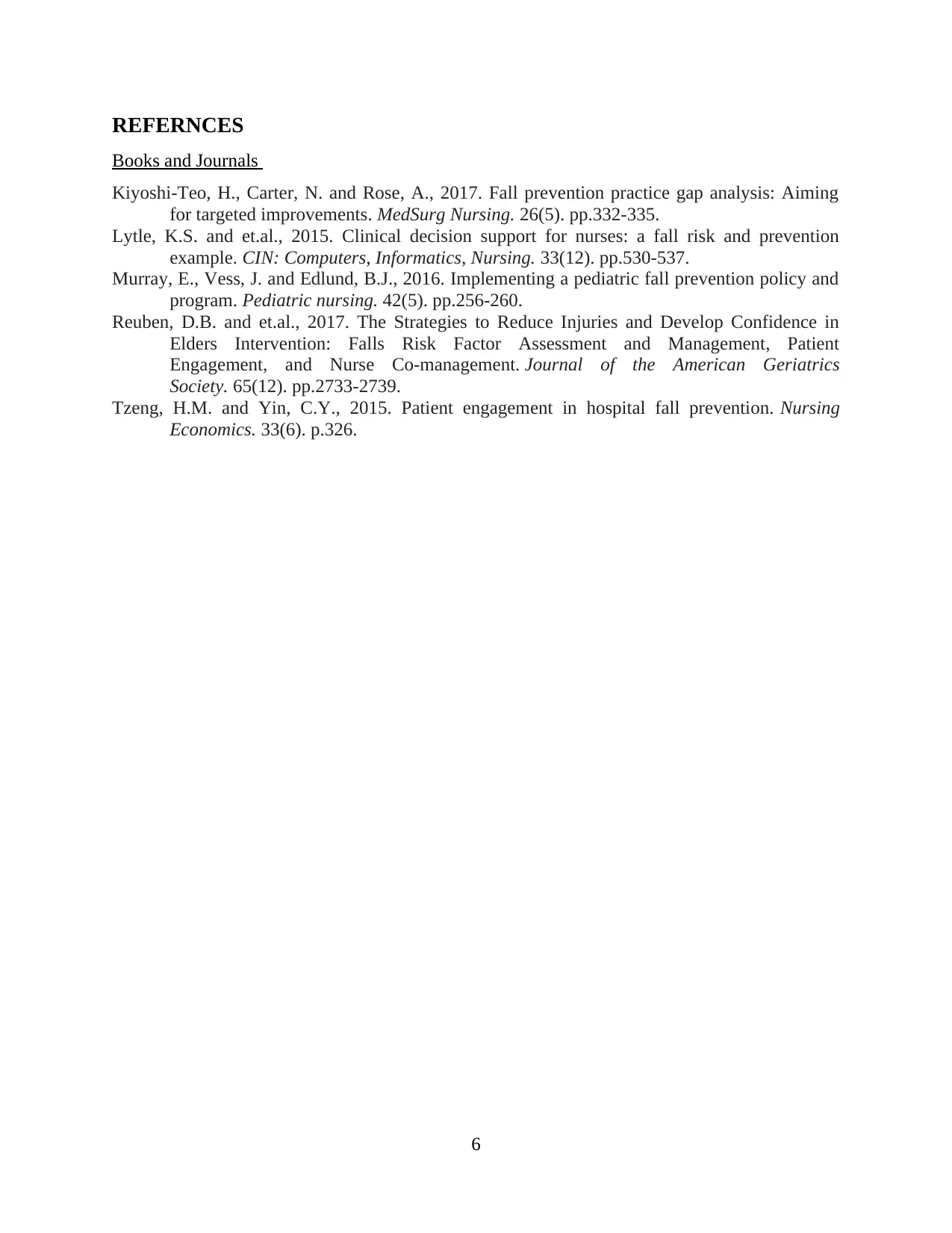
REFERNCES
Books and Journals
Kiyoshi-Teo, H., Carter, N. and Rose, A., 2017. Fall prevention practice gap analysis: Aiming
for targeted improvements. MedSurg Nursing. 26(5). pp.332-335.
Lytle, K.S. and et.al., 2015. Clinical decision support for nurses: a fall risk and prevention
example. CIN: Computers, Informatics, Nursing. 33(12). pp.530-537.
Murray, E., Vess, J. and Edlund, B.J., 2016. Implementing a pediatric fall prevention policy and
program. Pediatric nursing. 42(5). pp.256-260.
Reuben, D.B. and et.al., 2017. The Strategies to Reduce Injuries and Develop Confidence in
Elders Intervention: Falls Risk Factor Assessment and Management, Patient
Engagement, and Nurse Co‐management. Journal of the American Geriatrics
Society. 65(12). pp.2733-2739.
Tzeng, H.M. and Yin, C.Y., 2015. Patient engagement in hospital fall prevention. Nursing
Economics. 33(6). p.326.
6
Books and Journals
Kiyoshi-Teo, H., Carter, N. and Rose, A., 2017. Fall prevention practice gap analysis: Aiming
for targeted improvements. MedSurg Nursing. 26(5). pp.332-335.
Lytle, K.S. and et.al., 2015. Clinical decision support for nurses: a fall risk and prevention
example. CIN: Computers, Informatics, Nursing. 33(12). pp.530-537.
Murray, E., Vess, J. and Edlund, B.J., 2016. Implementing a pediatric fall prevention policy and
program. Pediatric nursing. 42(5). pp.256-260.
Reuben, D.B. and et.al., 2017. The Strategies to Reduce Injuries and Develop Confidence in
Elders Intervention: Falls Risk Factor Assessment and Management, Patient
Engagement, and Nurse Co‐management. Journal of the American Geriatrics
Society. 65(12). pp.2733-2739.
Tzeng, H.M. and Yin, C.Y., 2015. Patient engagement in hospital fall prevention. Nursing
Economics. 33(6). p.326.
6

7
⊘ This is a preview!⊘
Do you want full access?
Subscribe today to unlock all pages.

Trusted by 1+ million students worldwide

8
Paraphrase This Document
Need a fresh take? Get an instant paraphrase of this document with our AI Paraphraser

9

10
⊘ This is a preview!⊘
Do you want full access?
Subscribe today to unlock all pages.

Trusted by 1+ million students worldwide
1 out of 12
Related Documents
Your All-in-One AI-Powered Toolkit for Academic Success.
+13062052269
info@desklib.com
Available 24*7 on WhatsApp / Email
![[object Object]](/_next/static/media/star-bottom.7253800d.svg)
Unlock your academic potential
Copyright © 2020–2025 A2Z Services. All Rights Reserved. Developed and managed by ZUCOL.




